Overcrowding 1) How Did We Get Here? Human Tendencies
There are generational impacts on the world we see today, with actions set in place long before our existence.
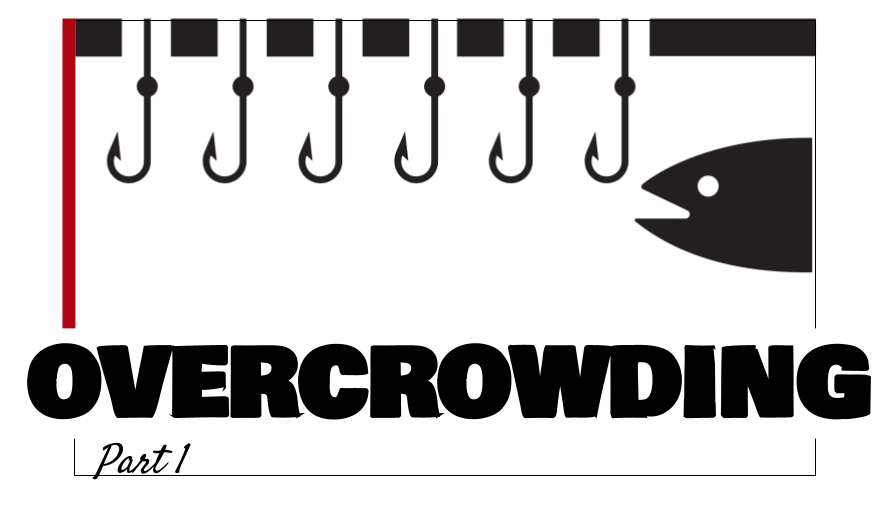
Welcome to the first installment of our new series on overcrowding, examining how we got here and where we go next to find new solitude.
Recreational fishing has its own quarks, but draws a lot of similarities from commercial fishing. Instead of harvest, and depletion, fly anglers may deal with recovery after angling and the concept of “weary” fish. Regardless, the body of water is changed by an angler’s presence. Successful recreational anglers do in fact leave a fishery in an altered state. Though the concept of “leave no trace” is an admirable and important goal for any outdoor recreationalist, humanity always leaves some kind of trace. There are generational impacts on the world we see today, with actions set in place long before our existence. These are the first places to look in understanding how fly fishing got to this point of overexploitation and overcrowding.
Shifting Baseline Syndrome
It's no coincidence that your grandparents remember a different world than the one we are living in today... You've probably heard folks from the Silent and Baby Boomer generations say something like, "The fishing ain't what it used to be." And they aren't wrong. In the U.S., we've been slow to acknowledge and recognize the impacts humans have had on things like water or fishery quality. We've increased the amount of pollution and greenhouse gasses in the world, and scoured critical habitat for human expansion. If environmental degradation is at an all time high, then why aren't people more aware of the profound impacts we have had and continue to have on the natural world?
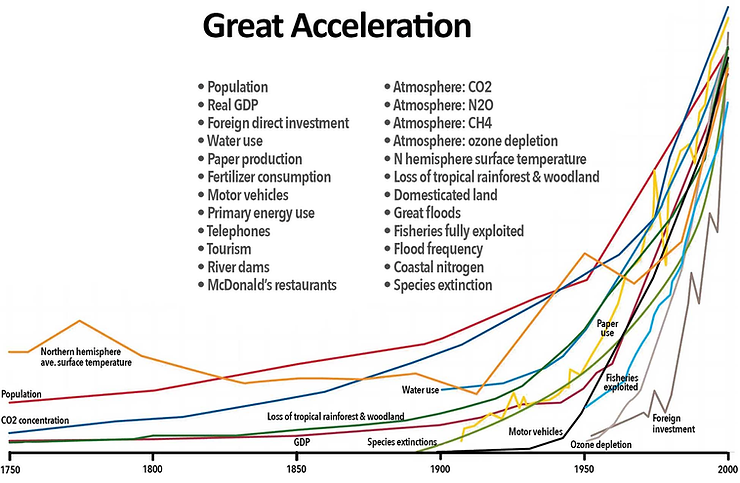
Source: Engelke & McNeill
Imagine that your family harvests fish from a lake where fish populations are declining from over-harvest. This lake originally became popular due to its once-robust fish population, and many families harvest fish for their livelihood. We can consider the baseline as the approximate number of fish living in the lake at any time. Due to extensive over-harvesting, the initial fish population drops over your grandfathers lifetime, and he notes how many fish he used to catch. When the business is finally inherited by the son, your father, the population has already dwindled but your father has a different perception of baseline conditions and how many fish are 'normally' harvested. By the time you take over, you've heard the stories from your family, but your 'normal' harvest is seemingly consistent, leading to another different perception of baseline conditions. If you were the first one in the family to record the average number of fish you were harvesting, losses might not even seem as dramatic unless you had your grandfather's numbers for comparison. These are the conditions you've always known and seen... and accepted. Even though grandpa might have told stories about how it used to be, you’ve never seen that yourself and can’t truly appreciate what that was like.
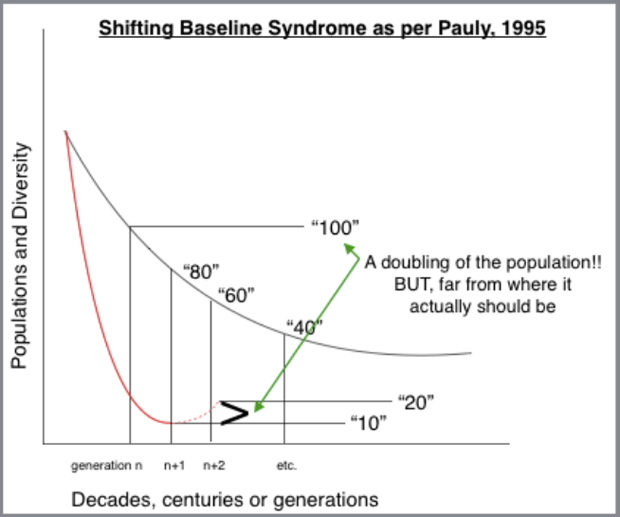
Source: Karrow
This problem, coined as the Shifting Baseline Syndrome, has been documented as a psychological and sociological phenomenon where people's assumptions about how natural conditions are inherited are assumed to be how things always were. Turns out, our society is pretty bad at tracking trends over time, especially if they aren't looking closely. Plus, scientists are still putting pieces together to understand the full dynamics of the natural world, and findings can easily be complicated by complex social-ecological interactions, or temporal and spatial intricacies. Basically, we don't always have a clear enough picture to get a true baseline. Or, the baseline numbers look different throughout time.

Light pollutions has shifted the baseline of what we think the night sky looks like
Conservation Implications
A shifting baseline can be especially problematic when creating conservation and restoration strategies, especially when we are trying to answer difficult questions, like:
- To which baseline are we attempting to restore a system? One that existed 10 years ago? 20? 50? Or even 100?
- What is a reasonable baseline?
- How much habitat was lost from that baseline?
- What was the population of species X at this baseline?
- To what level are we trying to restore the conditions?
For well-studied species, there might be a decent record to review, but many species are still poorly understood. For example, the Bonefish and Tarpon Trust has only recently learned some basic life history details for several well-loved flats gamefish. Another example; by the time catch and release practices were set up for Washington sea-run coastal cutthroat trout, an estimated 70% of some important coastal habitats were already lost. But how do we know it was only 70%? That number is dependent on someone's baseline assumption...
Boiled down...If we want to restore an ecosystem to baseline conditions, how do we know that the baseline represents a point in time when the resource was thriving? If we want to improve fishing conditions, where is the point where we say the job is done?
Going back to the lake example, the grandson might have a baseline expectation that’s radically depleted compared to that of their grandfather. Successful restoration based on the grandson's benchmark would be minimal in comparison to the grandfather's benchmark. If the grandson was asked whether or not the lake was depleted, he'd be more likely to say no, while his father and grandfather would almost assuredly note that the lake has been depleted. Researchers have recently compiled research suggesting this isn’t just the older generations lamenting the way things used to be, but more likely attributable to “society’s creeping amnesia” about environmental degradation.
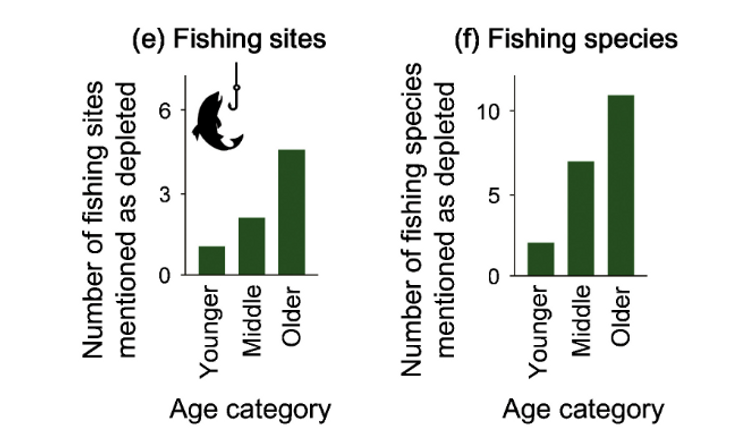
Source: Soga & Gaston
Unfortunately, species protection laws like the U.S. Endangered Species Act try to quantify how much critical habitat is required to adequately protect a species from extinction. This process involves establishing baselines and checkpoints to monitor success. Too often, ”grandson” numbers get used and as a result, species bounce on and off the list... again and again, unable to re-establish without human supplementation. Policy makers subject to shifting baseline syndrome may under-represent the amount of habitat or population requirements needed to stabilize threatened and endangered species.
More nefariously, intentionally shifting windows of what baseline conditions actually entail can lead to a species avoiding a listing altogether, despite any overwhelming witness claims of degradation from elder generations. Sometimes economic incentives influence whether or not a species is listed or not. A listing of any salmon in the Snake River drainage could have economic impacts related to a loss of the dam/lock system, which would be removed to facilitate salmon migration if they are ever listed.
We think the world of conservation should be rooted in ecology and sound science; but humanity's role in monitoring and maintaining the natural world is bound by our own psychology. If we are to take over the responsibility of overseeing and mitigating the damage we cause to other species, we need to recognize the psychological shortcomings that impair our ability to live up to that responsibility. It impacts how we think about our fisheries.
So, set in place has been a history of misguided numbers, different perceptions of fish stocks, and cock-eyed optimism for younger generations, un-aware of any history. Though losses aren’t consistent across the aquatic world, the trends are consistent. Loss in coral cover surrounding Papua New Guinea has led to a 75% decline in fish abundance, with over half of those fishing declining in population size by at least 50% or greater (between 1996-2003). Declining despite being found in marine reserves, protected from exploitation. The trends are similar for freshwater. Since 1970, 83% of freshwater species have seen declines, losing around 30% of their ecosystems.
But despite environmental or grassroots or political movements, there’s something deeply seeded in human motivations that erodes productive policy change. Something every angler is guilty of too.
Tragedy of the Commons
When society shares access to common resources, especially natural resources, an individual's short-term interests can be in direct conflict with the greater, or common, good. An individual has the ability to benefit from using a resource while potentially creating negative effects for everyone else. In other words, an individual's rational exploitation of a common resource can create externalities for which everyone sharing the resource bares the negative side-effects. This is the tragedy of the commons – an idea posed by the American economist, Garrett Hardin.
A simple example: If a lake is a shared resource for commercial fishing, each fishing operation seeks to maximize the amount of harvested fish regardless of potential impacts to other fishing operations. In the short-term, there is no incentive for each operation to consider limiting the number of fish they catch. Any fish lost is an opportunity lost to other commercial operations. Economically, it's in each operation's best interest to harvest as many fish as possible to gain the greatest profit. Any decline in fish populations are shared amongst the collective fishing operations and does not impact one operation more-so than the others, assuming they all have the same fishing abilities and resources. Generally speaking: optimizing one's own self-interests at the expense of the resource and the well-being of others is a rational thing to do, and so everyone with their self-interests at heart will do the same, and over-exploitation will lead to the collapse or destruction of the shared resource.
People knowingly do this all the time. In fact, tragedy of the commons issues are seen across the globe in all kinds of ways: overfishing oceans, creating air and water pollution, overgrazing shared pastures, over-prescribing antibiotics, littering, water shortages, deforestation, draining regional aquifers, the list goes on.
Tragedy of the Commons in Recreational Fishing
Guiding operations pose issues similar to those in the previous fishing example. On public waters, each guide service seeks to increase profits by maximizing their time on the (shared resource) river. Of course, angling success is the usual goal, not harvesting fish. As each guide service sends out boats or guides to help catch fish for their clients, the short-term gains are seen as income, but the long-term effects are felt by the fishery, the river ecosystem, and others fishing the river. Hooking mortality, fish behavioral shifts, and habitat degradation may each develop as consequences of the short-term gains. These problems are only amplified on waters filled with guides and anglers alike, those most desirable angling destinations.
Still, Growth…
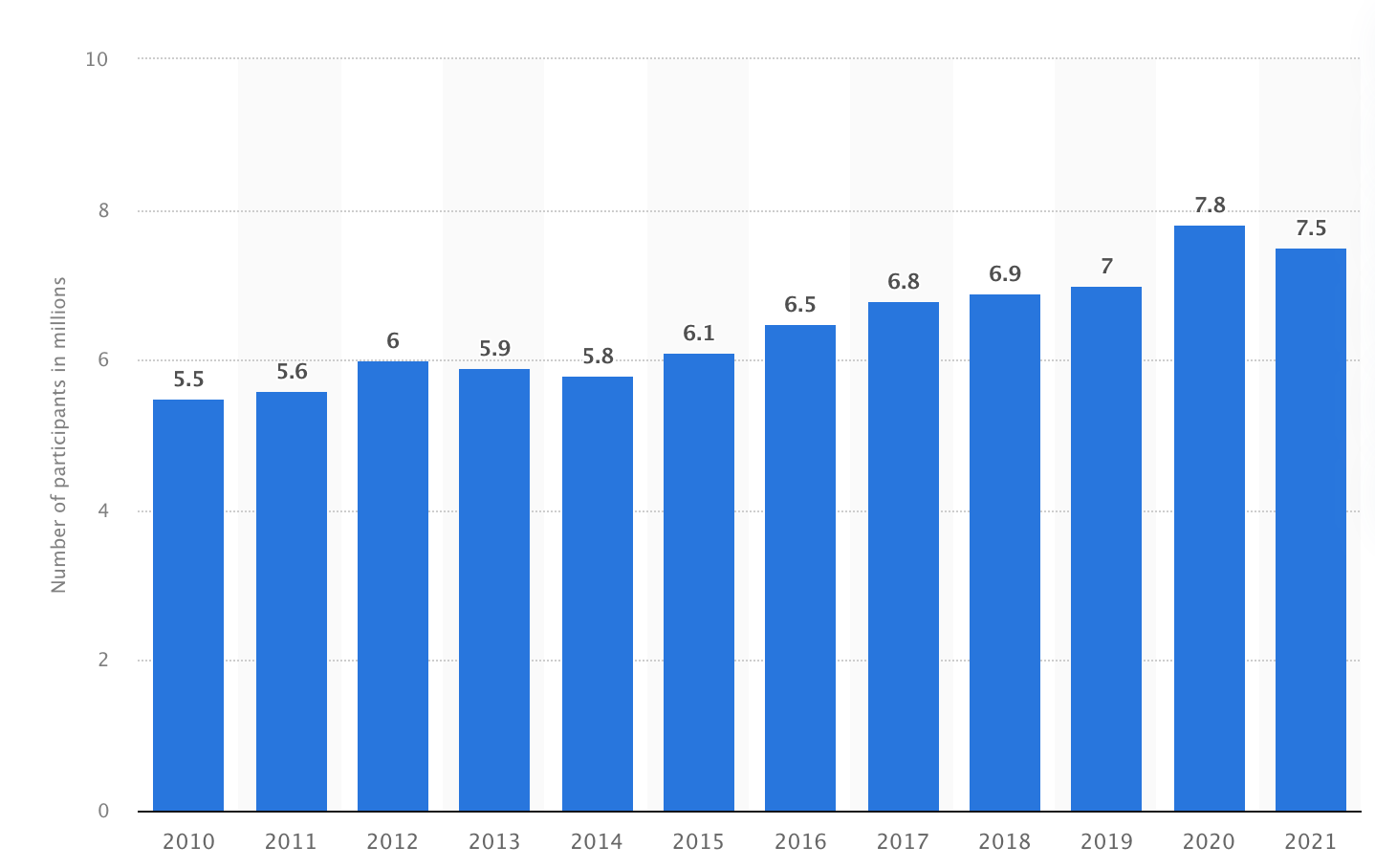
Statistica, 2022
Despite these underpinning issues constantly swirling around in the world of fisheries, new anglers are finding fly fishing. The number of fly fishers has grown consistently since 2010, estimates suggest a rise in 2 million anglers, peaking at 7.8 million in 2020, and slightly receding to 7.5 million in 2021.
But is supply meeting demand? We’ve observed losses in fish stocks for numerous freshwater and saltwater species, but there are more anglers than ever… so what are people catching? Well the answer in freshwaters is, hatchery raised fish. Mostly Rainbow Trout.
Sources:
- Karrow, T. 2015. Ghost Stories: Bahamas' Bonefish and Shifting Baseline Syndrome. Fly Life Magazine. https://flylifemagazine.com/ghost-stories-bahamas-bonefish-and-shifting-baseline-syndrome/
- Stoll, R. 2017. Sea Run Cutthroat Trout; California to Alaska: A saltwater Fly Anger's Guide to Their Biology, Prey, Angling Strategies, and Conservation. West Sound Angler.
- Soga, M & Gatson, K. 2018. Shifting baseline syndrome: causes, consequences, and implications. Frontier in Ecology and the Environment. 16-4. https://esajournals.onlinelibrary.wiley.com/doi/10.1002/fee.1794
- Engelke, P. & McNeil, J.R. 2016. Are we at the beginning of a new geological era? https://www.georgetownenvironmentalhistory.org/home/peter-engelke-and-john-mcneill-in-the-washington-post-for-earth-day-are-we-at-the-beginning-of-a-new-geological-era
- Geranios, N. 2019. Study Examines Pros And Cons Of Removing Snake River Dams. Associated Press. https://patch.com/washington/across-wa/study-examines-pros-cons-removing-snake-river-dams
- Jones, G. et al. 2004. Coral decline threatens fish biodiversity in marine reserves. PNAS. 101-21. 8251-8253. https://doi.org/10.1073/pnas.0401277101
- Banyan, M. Accessed 2023. Tragedy of the Commons. Britannica. https://www.britannica.com/science/tragedy-of-the-commons
- Statistica. 2022. Number of participants in fly fishing in the United State from 2010 to 2021 (in millions). https://www.statista.com/statistics/315900/number-of-fly-fishing-participants-us/#:~:text=The%20participation%20in%20fly%20fishing,million%20anglers%20in%20those%20years.


